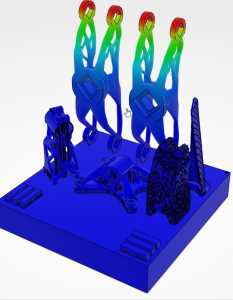While Additive Manufacturing (AM) has opened up possibilities for product design that only a few years ago were not even contemplated, the industry is still struggling with unknowns: part distortions, residual stress, process repeatability, microstructure evolutions, surface finishing, etc. Along with opportunities, engineers also face challenges. It is here that Dassault Systèmes realized the industry gaps to transition AM from prototyping into production. Dassault Systèmes has since then heavily invested and committed to offering a comprehensive digital platform to advance AM technologies for industrial production. The comprehensive digital platform – the 3DEXPERIENCE platform – connects end-to-end from the beginning – design – to the finish – production – among different experts in an organization including designers, machine process specialists and analysts on premise/cloud.

The AM journey begins by answering the first question a designer has: how to design the shape of the part/assembly to meet the in-service loading condition, but also make it lighter at the same time with the unique capability of additive manufacturing software to build organic shapes. Topology optimization solutions are customized to address AM specific constraints such as overhang minimization, mechanical and thermal loads validation, single/multi-part optimization, and enables smooth transitions from optimization results back to geometry, shortening months of manual work needed for new organic CAD reconstruction from FEA mesh to seconds with a click of a button.
Followed by design and optimization, the platform is committed to solve the build planning and manufacturing process in a multi-scale multi-physics approach, because it is essential to capture the melting/solidification physics at milliseconds in time and micrometers in length, as well as overall printing processes of a typical production part at hours in time and millimeters in length. Engineers can prepare their build process, orient/nest parts on the build tray, generate/minimize support structures. With different multi-physics simulation methods engineers could choose to perform a detailed thermo-mechanical analysis to predict complex physics – such as buckling and microstructure evolution – or a direct stress analysis based on a pre-defined eigenstrain library.
Distortion predictions can be mapped back to create compensated designs. Microstructure morphology and phase contents prediction can be mapped to as-built material behaviors. In addition, Voxel meshing with scanned geometries, lattice optimization, support analytics, heat treatment, machining, cracking, in-service loading and durability can all be performed.
Rated as first place in residual stress prediction by NIST AM Benchmark, the process simulations are validated and can be performed regardless of the process type (SLM, FFF, FDM, LDED, EDAM, MJFTM, SLS, etc.) or material (Ti64, aluminium, steel, IN625, IN718, etc.).
What to learn more about Dassault Systèmes’ simulation solutions for additive manufacturing? Visit: go.3ds.com/Print2Perform
